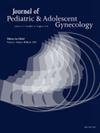34. Entonox Sedation For IUD insertion In Adolescents - A pilot Project
IF 1.8
4区 医学
Q3 OBSTETRICS & GYNECOLOGY
引用次数: 0
Abstract
Background
The use of inhaled Entonox is a novel approach to providing patient-controlled sedation for an IUD insertion. Entonox sedation can be use in a clinic situation without the need for IV or Anesthetists. The tanks are portable and can refilled and the masks are inexpensive to purchase.
Methods
16 subjects were recruited for IUD insertion with patient-controlled Entonox. Informed consent for an IUD insertion and pilot study was obtained. Subjects were included with the following: age greater than 15, BMI less than 30, Patient has had failed attempts at IUD insertion in the clinic or it has been determined through patient assessment that sedation is required to support insertion. Developmentally able to self-administer Entonox. Exclusion criteria included: Patients less than 15, existence of co-morbidities, experienced sexual trauma, known anatomical concerns. Pregnancy tests were performed prior to insertion and routine vaginal swabs taken at time of insertion. Insertions took place in induction rooms and in outpatient clinics. Each patient received a satisfaction survey following insertion using a QR code in Redcap. IRB approval was obtained.
Results
16 patients were consented and 100% of them had an IUD successfully inserted under patient-administered Entonox in a clinic setting. The satisfaction survey revealed a satisfaction rate of 90% (range 7-10). 10/16 (62.5%) responded to the redcap survey. The patient's perception of success was 86% range (5-10).
Conclusions
Entonox patient-administered sedation is an excellent option for insertion of IUD in adolescents. This method allows sedation in a clinic setting and will significantly reduce the demands on expensive resources such as OR time or anesthesia lead procedural rooms. As this is a pilot study numbers are small, only 16 patients, and we recommend confirming outcomes with a larger cohort. Entonox patient-administered anesthesia could also be expanded to support IUD insertions in the adult clinics.
34. 炔诺酮镇静用于青少年宫内节育器植入-一个试点项目
背景:在宫内节育器插入过程中,使用吸入的恩托诺是一种提供患者控制镇静的新方法。依诺诺镇静可以在临床上使用,不需要静脉注射或麻醉师。气罐是便携式的,可以再加注,面罩也不贵。方法16例患者采用自行控制的恩妥诺进行宫内节育器置入。获得了宫内节育器插入和试点研究的知情同意。受试者包括以下条件:年龄大于15岁,BMI小于30,在临床尝试植入宫内节育器失败或通过患者评估确定需要镇静来支持植入。能够自行使用安替诺。排除标准包括:患者小于15岁,存在合并症,经历过性创伤,已知解剖学问题。插入前进行妊娠试验,插入时进行常规阴道拭子检查。插入在诱导室和门诊诊所进行。每位患者在Redcap中插入QR码后接受满意度调查。获得IRB批准。结果16例患者同意,100%的患者在临床环境中在患者给药的恩通诺下成功植入宫内节育器。满意度调查显示满意率为90%(范围为7-10)。10/16(62.5%)回应了红帽调查。患者对成功的感知为86%范围(5-10)。结论安妥诺镇静是青少年宫内节育器置入的一种较好的选择。这种方法允许在临床环境中镇静,并将显著减少对昂贵资源的需求,如手术室时间或麻醉引导手术室。由于这是一项初步研究,人数很少,只有16名患者,我们建议用更大的队列来确认结果。依托诺病人麻醉也可以扩大到支持成人诊所的宫内节育器插入。
本文章由计算机程序翻译,如有差异,请以英文原文为准。
求助全文
约1分钟内获得全文
求助全文
来源期刊
CiteScore
3.90
自引率
11.10%
发文量
251
审稿时长
57 days
期刊介绍:
Journal of Pediatric and Adolescent Gynecology includes all aspects of clinical and basic science research in pediatric and adolescent gynecology. The Journal draws on expertise from a variety of disciplines including pediatrics, obstetrics and gynecology, reproduction and gynecology, reproductive and pediatric endocrinology, genetics, and molecular biology.
The Journal of Pediatric and Adolescent Gynecology features original studies, review articles, book and literature reviews, letters to the editor, and communications in brief. It is an essential resource for the libraries of OB/GYN specialists, as well as pediatricians and primary care physicians.

 求助内容:
求助内容: 应助结果提醒方式:
应助结果提醒方式:


